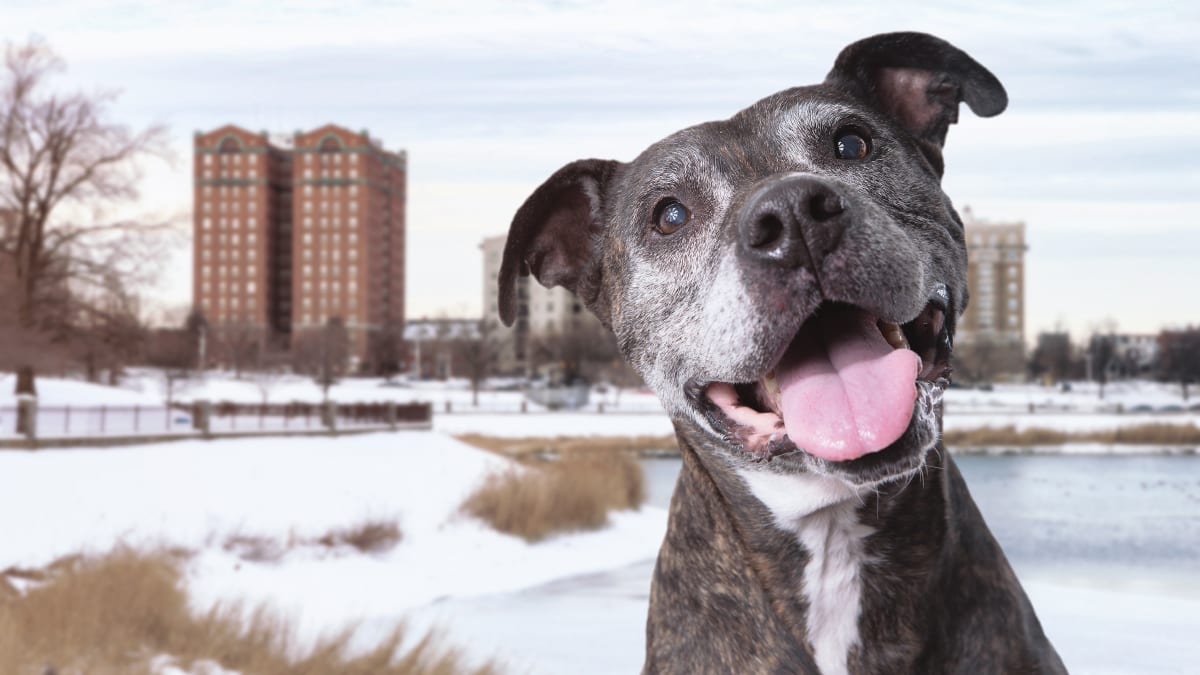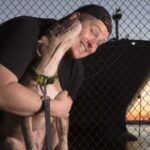Written by J.B. Shepard, professional pet photographer and founder of the Puptrait Studio.
What could possibly be more adorable than photos of a dog frolicking in the snow?
Absolutely nothing.
Your dog is never more fun than when it’s a play and this is especially true on snow days. Snow is a new and exciting experience for most dogs. And, when a serious blizzard rolls through the area odds are you’re taking off from work — which our dogs are understandably pretty jazzed about.
If you’re a new photographer, you’ll learn to hate snow
A lot of Puptrait fans don’t know this, but while Baltimore might be my home I actually grew up in Mount Washington Valley, deep in the White Mountains of New Hampshire. I say that to say this, snow is in my blood. I was downhill skiing before I could walk — I’m not even kidding, my parents put me in knee-high skiboots, strapped my skis together with metal clamps and literally pushed me down the mountain (it was the early 80’s — a simpler and more injury prone time). I even drove snowmobiles before I learned to ride a bike. And, unlike most other Game of Thrones Fans, I’m not ashamed to to admit I was rooting for the Night King and the rest of the White Walkers the entire time GOT was on the air.
Needless to say, I love snow…
…except for when it comes to shooting.
I can’t think of a worse environment to shoot in than the middle of winter Nor’easter. And, honestly regular blizzards and Maryland’s signature “wintry mess” nonsense are not much of an improvement. For the simple fact that cameras and snow, as my beloved late Nan would say, “go together as well as peanut butter and bird sh*t.”. No matter how well you mix them together, they’re going to leave a bad taste in your mouth.
Photographing dogs in snowy conditions presents unique challenges
Here is a short list of things that give photographers nightmares…
- Static discharge
- Trembling hands and shivers
- Moisture and spills
- Drops and shock damage
- Slippery surfaces
- Extreme temperatures
- High speed winds
- Low light conditions
- Scenes that are both extremely bright and dark
- Shiny glare inducing surfaces
Here’s the thing, ever single one of those points is something that commonly occurs in snowy conditions. In fact, it’s not unusual to experience all of those conditions at the same time. I mention this partially to rant, but also to explain that the best camera setup for more extreme weather events is radically different than the best camera set up for more mild weather conditions.
When you think “snowy”, exactly how much snow are we talking about?
Before choosing the best camera to photograph pets in “snowy” conditions ask yourself these three basic questions…
- How cold is it?
- How wet is it?
- How likely am I to drop my camera?
Now ask yourself those questions again, but remember that you’ll be crawling around on the ground photographing a dog that will likely be running around like an absolute maniac.
^ Try to keep that thought in mind while you continue reading.
What is the best camera for photographing dogs in snow, when it’s not snowing?
If there’s snow on the ground, but the location is otherwise fairly dry and relatively warm, pretty much any camera with manual exposure controls will work.
PRO TIP: Whenever bringing your camera into the field for a photo shoot, pack an unscented trash bag or two. While not entirely waterproof, most plastic bags are pretty water and moisture resistant (more so than most camera bags). Don't be afraid to toss your entire camera bag in a plastic bag if it starts to rain, snow, or if you are crossing slushier / slippery surfaces.
Any new full frame DSLR (from Canon or Nikon) or new flagship Mirrorless camera (from Sony or Toshiba) will perform exceptionally well in snowy conditions as long as it is kept dry and in temperatures above freezing. Seriously. They’re all great and in competent hands, will produce amazing photos.
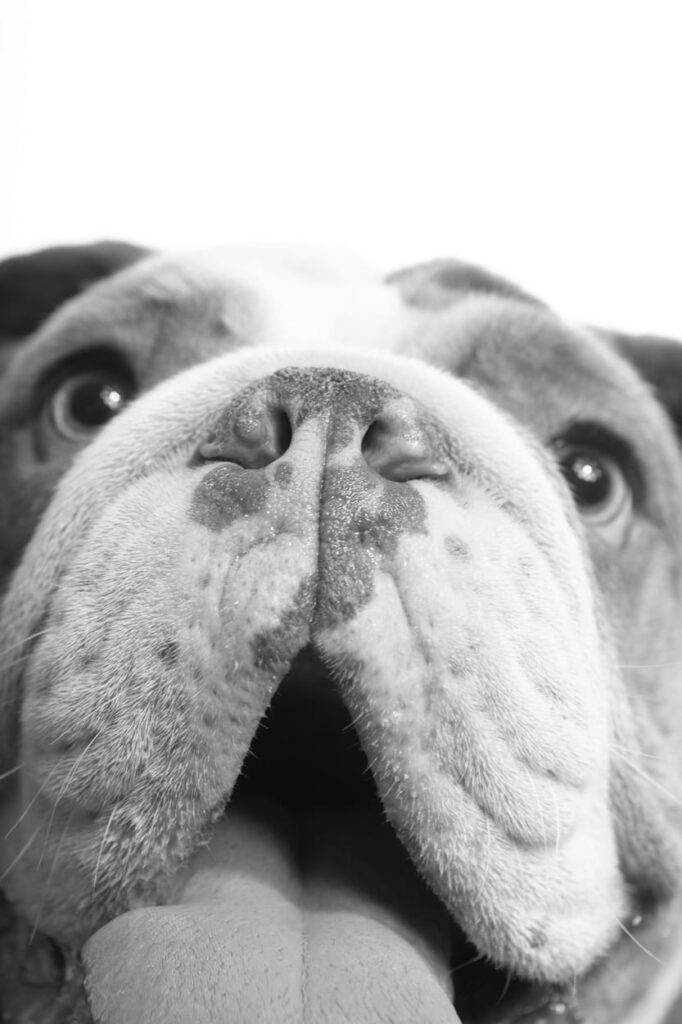
What is the best camera for photographing dogs when it is cold AND snowing?
If you are photographing pets in conditions that are wet, subfreezing, or if there is a chance you’ll slip and drop your camera, you may want to consider a camera that is a bit more durable than a more fragile DSLR camera.
What are durable cameras?
Durable cameras are cameras that are resistant to drops, spills, dust, and other mishaps typically associated with outdoor adventures and inclement weather. The cameras are generally housed in dustproof and waterproof cases, and are advertised as “adventure cameras”. In addition to being more durable than normal cameras, they’re typically designed to be easy to find due to being brightly colored, tracked via eGPS, or feature audible / visual alarms that can be triggered remotely by smartphone.
Have a camera you like, but wish it was more durable?
It’s difficult to make a camera more shockproof or freeze proof. But just because a camera isn’t advertised as “water proof”, doesn’t mean that it can’t be taken underwater (with the help of a few adjustments or accessories). The same cane be said for cameras that are not natively dust proof.
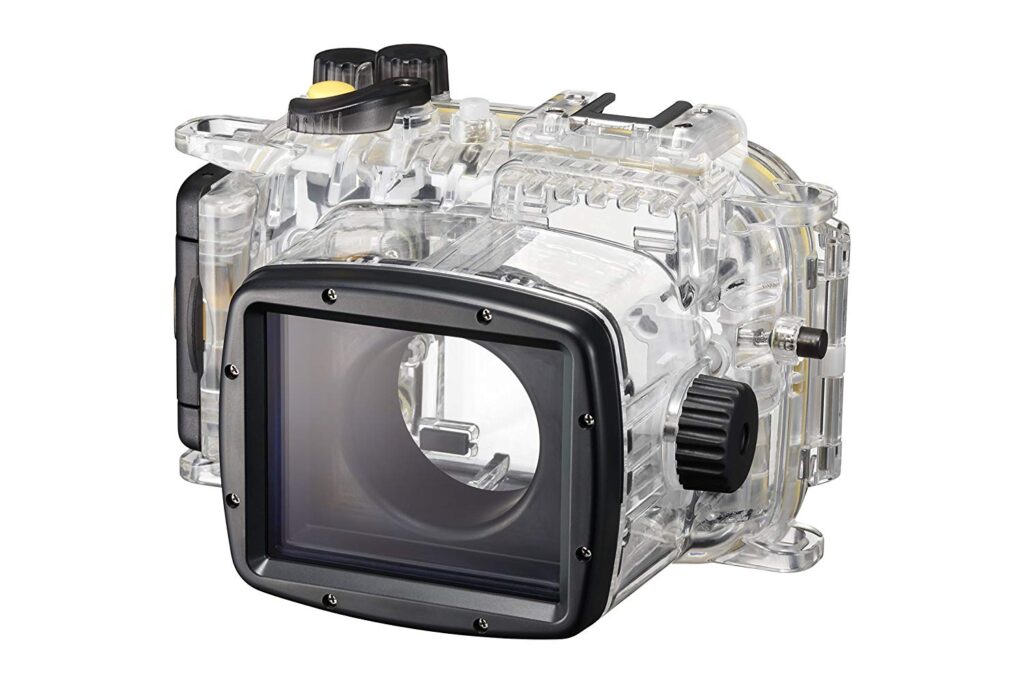
Most major camera manufacturers make water proof camera housings. They are not especially cheap and they are certainly not fool proof. But when quality counts, water proof camera housings can be an absolute godsend. If you are working in especially snowy or slushie conditions, you may want to consider picking up a waterproof housing for your camera.
The best camera to shoot in messy winter conditions
Before I get into my recommendation, let me start by saying that I’m usually a pretty loyal Canon user. I shoot all of my production work at the Puptrait Studio with red ring zooms on my Canon 5D mark iii full frame DSLR. And, if I was going doing a snowy photoshoot with relatively still subjects in temps above freezing, that would be my automatic go to (hip hop hooray for insurance).
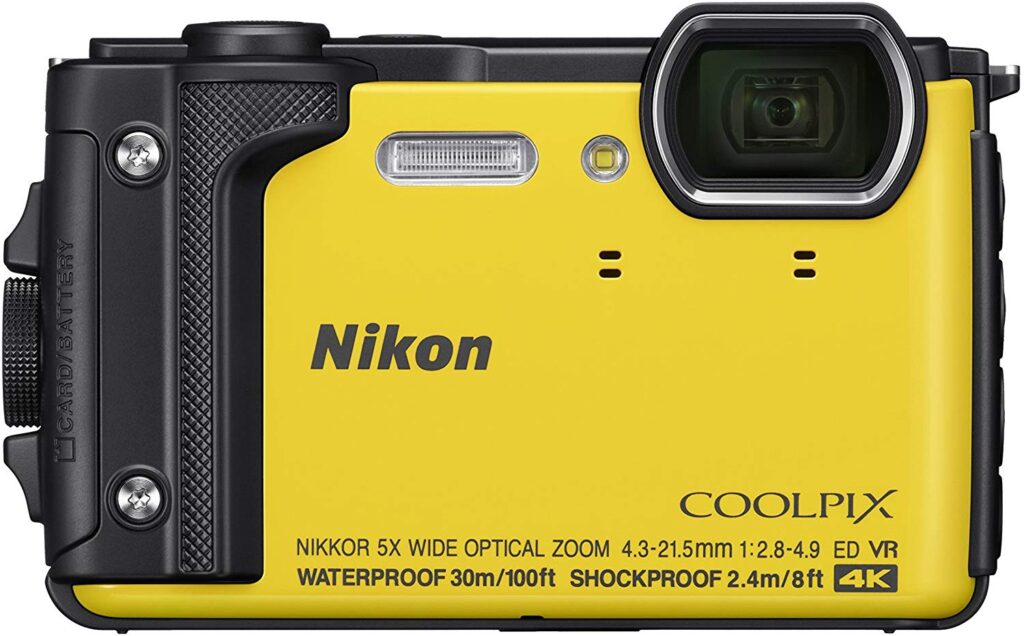
But brand loyalty aside, Nikon really impressed me with their super durable COOLPIX W300 (~$400). If I was shooting models outside and knew that we would be active or tossing snow around (and wasn’t shooting a billboard), this is absolutely the camera I would use. Seriously.
Nikon Coolpix W300 specs:
- Ultra durable – Waterproof + Shockproof + Freezeproof = Snowballproof
- Comes in high-visibility yellow and orange, and not-quite-as-visible black
- 16 MP CMOS backside illuminated 6400 ISO digital sensor
- 5X optical wide zoom f/2.8 – f/4.9 Nikor lens
- Wifi and Bluetooth connectivity
- Hybrid VR image stabilization (IS)
- Large glove friendly buttons
- Auto Focus and Contrast-detect Auto Focus
- GPS, eCompass, altimeter, and depth gauge
- Quick charging time (2 hours and 20 minutes)
- 4K Ultra HD video
- Built in LED light & flash
- 20 different shooting modes
- 3 inch LCD screen
Wait – your “best camera” recommendation is a point and shoot?
To be clear, I am not normally one to recommend point and shoot cameras for most photographers. Don’t get me wrong, they are great for those shooting while traveling and for teaching younger photography students, that might get overwhelmed by more sophisticated camera controls.
Point and shoots are generally designed primarily with convenience and cost in mind, not image quality or creativity. As someone who makes a living from image quality and creativity, I’m understandably not a huge fan of point and shoots — usually. But this is the exception that proves the rule.
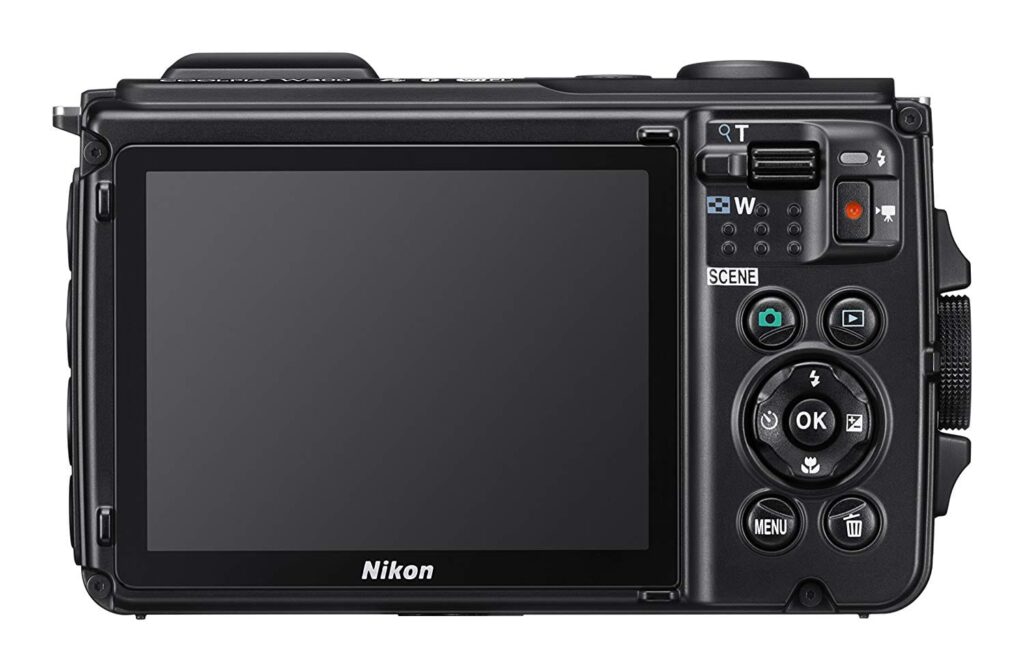
Durability paired with specs that’ll get the job done
As you’d expect, the 16 MP sensor on the W300 isn’t huge. But that’s enough resolution to print photos up to 10″ x 16″ at 300 DPI and while its sensor might be relatively small, it’s also backside illuminated. Which means it will perform great when trying to capture scenes with extreme dynamic ranges (i.e. snowy conditions).
In any other situation, this is absolutely not the camera I would pick — but this isn’t your typical situation.
Honestly, even as far as point and shoots go, the W300 is not the most technically impressive camera. But when you compare the W300 to other similarly durable cameras, this thing performs absurdly well. I’d go so far as to say that it takes surprisingly great photos for a waterproof camera.
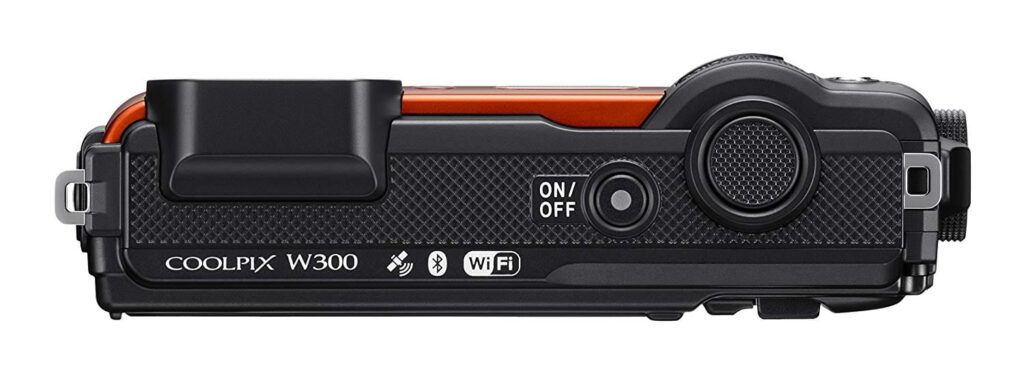
A fresh take on the durable camera niche
Unlike most adventure cameras (which are typically fixed focus), the W300 features a built in 5x optical zoom Nikor lens. The camera also boasts tripod support, can shoot in low light conditions with an ISO up to 6400, has subject tracking AF, and it can shoot in 4k UHD (30/25p) or up to 7 full res still frames a second — twice the captures my full frame DSLR Canon 5D mark ii is capable of in burst mode.
The W300 also features some nice quality of life upgrades like tripod support, hybrid VR image stabilization, GPS, eCompass, altimeter, depth gauge, built in Wifi and Bluetooth connectivity.
But more importantly, the W300 is dustproof, shockproof up to 2.4 meters (~8′) waterproof up to 100ft, freezeproof to -10C (14F), and comes in a high-vis yellow and orange.
Meaning, if you drop this camera in the snow…
a) it won’t break
b) you’ll actually be able to find it
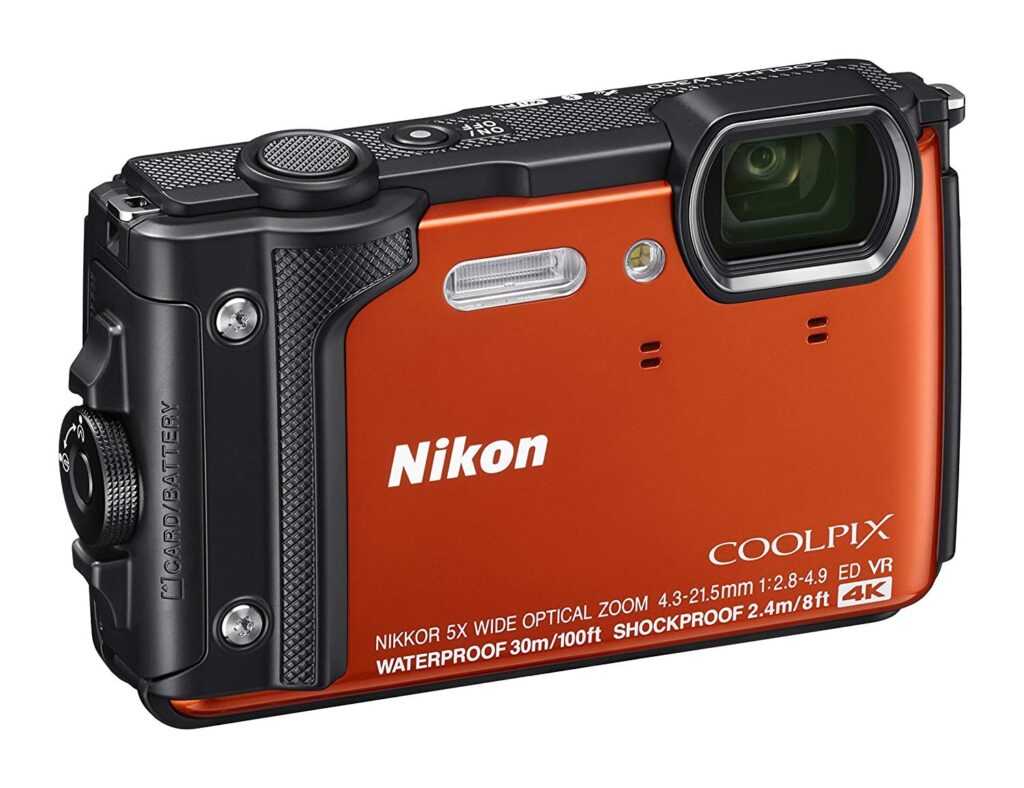
What does “best” mean anyways?
Technical specs are important — but they’re not the entire picture. Don’t get me wrong, there is certainly a floor when it comes to technical specs and image quality. But at a certain point, resolution becomes a secondary factor. When we talk about the “best camera” we’re not evaluating specs in a vacuum. What we are really asking is, “what camera will help me take the best photos?”
When it comes to shooting pet portraits in snow, especially action shots, it’s less about what camera is technically the best, and more about what camera will give you the confidence to take the risks needed to create the best photos. And with that in mind, you would be hard pressed to find a camera that does that better than the Nikon W300 — let alone a better camera for under $500.
The Puptrait Studio may collect a share of sales or other compensation from the links on this page. Prices are accurate and items in stock as of time of publication.
About the author: J.B. Shepard, is a professional pet photographer, dog advocate, and founder of the Puptrait Studio. J.B. lives in Hampden, with his wife and two rescue dogs — George (a Boggle) and Lucky (a Jack Russell Terrier).

